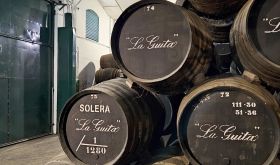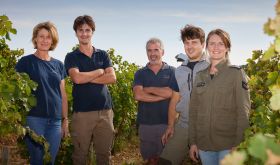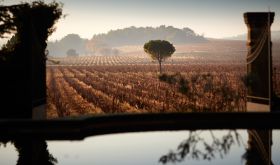From €16.48, 199.90 Norwegian kroner, £16.75, HK$180, 149 Danish kroner
It’s thrilling on the rare occasions that I discover an amazing wine that seems impossible to find outside its native region and then eventually see it achieve international distribution. This is true of Verum’s wines from La Mancha.
The story starts with an email from team member Tim Jackson MW who had been contacted by a fellow Master of Wine student, Elías López Montero based at his family’s winery in La Mancha. Elías had heard me express an interest in developments in La Mancha on a visit to Spain and wanted to know how he could send samples to me.
I have long been interested in La Mancha – not least because it is home to Airén, the grape variety planted on the greatest area when I was totting up statistics for my 1986 book Vines, Grapes & Wines (long superseded by our much more comprehensive and up-to-date Wine Grapes). Airén is not exactly famous but I felt that if it were so widely planted, and La Mancha’s vineyards were so extensive, there must be a story there.
I knew that much of the Airén grown supplied raw material for Spanish brandy, but clearly La Mancha must be the engine room of Spanish wine. As Ferran points out in this fascinating overview of La Mancha, written after I expressly asked him to research the region, La Mancha accounts for an amazing 30% of all land under vine in Europe and 48% of Spain’s entire vineyard area. The great majority of the grapes that are not distilled are sold as bulk wine shipped all over the world at almost unimaginably low prices (the major markets are France, Germany, UK, Russia and the US apparently) or transformed into other grape products such as grape concentrate and fruit juice.
As Ferran outlines in a tasting article devoted to Verum, Elías’s family owns the respected Altosa distillery but he has gone out on his own to create the fine-wine label Verum (strange that the name was not already taken) devoted to the region’s oldest vines and finest terroirs, and he is hard at work refining its produce. Ferran pictured him below.
In July 2019 Elías was in the UK and came to see me in our flat. I was fascinated to learn more about his ambitions, the situation in La Mancha and subsequently to taste his particularly exciting wines, mostly based on old vines of local varieties but also on others specially imported in an attempt to combat climate change.
Then in January of this year, told by Elías that he had appointed Enotria & Coe as UK importers of Verum, I contacted their buyer Peter Wallbridge and received this reply:
‘To introduce myself, I am a former winemaker (and Plumpton graduate) and following the last 10 years in Spain returned to the UK in January 2019 to be Enotria & Coe’s buyer for Spain and Latin America.
‘I met Elías about a year ago and I think he is incredible! Up there with the likes of Raúl Pérez and the Envinate lot by my standards and so pleased to hear you’ve encountered his wines before.
‘To explain the link, Ulterior is part of Verum and represents their flagship range. For me are they are by far the most exciting and progressive wines on the market. They were basically created to combat climate change which makes them a great talking point! These are the first vintages, so a world exclusive for us! Very exciting!!
‘As I’m sure you know, La Mancha is often called the sarten (frying pan) of Spain because it is so hot and dry. With climate change this is only going to get worse. For this reason about 15 years ago Elías decided to plant some later-ripening varieties which would "miss" the relentless summer heat as well as looking at others which need very little water to survive. Some of these were indigenous to La Mancha (such as Tinto Velasco) whereas others he brought from other regions (such as Graciano). They all form part of a single vineyard, El Romeral, and are grown organically (certified) as per all of Verum’s wines.
‘What makes them extra special is that Elías uses his grandfather’s old clay tinajas to make the wines. Some are only aged in tinajas, whereas others include the use of some oak as well. They are all really interesting and have just the right amount of "funk" to maintain interest, but without risking causing offence to anyone (as is the case for a lot of what I call "head banger" natural wines).
‘They are very unique in their individual style. The white Albillo Real/Albillo Mayor blend (the only one on the market to my knowledge) is super-autolytic and gloriously reminiscent of baked apple pie. With a bit of time some apricot comes through, as well as a beautiful salinity you wouldn’t necessarily spot when pouring the first glass from the bottle. The Garnacha is super-light in style with a lot of whole bunches going into the ferment. Both are exclusively aged in tinajas. Then there is the much richer Graciano (95 points at DWWA, the highest-scoring wine ever from La Mancha – and only the second Graciano after Contino’s) which sees a small percentage of 600-litre barricas (the rest in tinajas) and finally the Mazuelo, the most classic, aged in new oak barricas and oozing with elegant floral notes and incredible length.’
I love the delicacy of the Verum, Ulterior Parcela No 6 Garnacha Vino de la Tierra de Castilla and will be recommending it in my Financial Times article tomorrow about the transformation of this grape into a transparent, floral style. It’s called Parcela 6 because it’s grown on plot 6 in El Romeral vineyard, which is at about 700 m elevation so presumably provides some relief from the frying-pan heat. Half the (hand-picked) grapes are destemmed and the mix given a cold soak for five days before alcoholic fermentation with ambient yeast in 5,000-litre stainless-steel tanks. The resulting wine is then aged in the famous tinajas (earthenware jars) for 11 months. Elías deliberately reduced the yield between 2016 and 2017 but I love both wines and gave them both a high score of 17.
My tasting note for the 2017:
Very pale garnet. Earthy, meaty nose. Fresh, floral aspect of Garnacha. Completely belies its alcoholic strength. There's a hint of white chocolate but masses of refreshing acidity. I'm tasting it straight from the fridge and it's responding well. I definitely wouldn't serve it too warm. Very persistent. Sui generis. Whoever would have thought this would have come from the plains of La Mancha? But presumably vine age plays an important part. It's so lovely now, I do wonder what happens with bottle age.
My tasting note for the 2016:
Very pale ruby. Light nose with a hint of rose petals. Transparent and sweet to begin with and then dry and fresh on the end. Delicate but true to the variety. Very 21st century. Luscious and flattering but transparent too. Tangy with some meatiness of flavour and with the 'bitey' texture of clay-jar ageing.
There is considerable variation in the price of this wine. It’s dirt cheap in Spain but the 2017 is £16.75 from Exel Wines and £19.95 on Enotria & Coe’s retail website, The Great Wine Co.
But this is far from my only recommendation. I fell in love with Verum, Las Tinadas Airén de Pie Franco Vino de la Tierra de Castilla, made from ungrafted ancient Airén vines and selling for an even wider range of prices: from €10.50 in Spain (cheaper than the Garnacha – but then it’s white …) and Belgium but £20.95 from Exel Wines and £25 from The Great Wine Co website.
My tasting note on the 2018 (and the 2019 is every bit as good):
From ungrafted Airén planted in a single plot on chalky soils in La Mancha in 1950 – my vintage! Aged in clay tinajas.
Gosh this is good. Broad honeysuckle nose but not fat. Notes of honey, lime and minerals on the palate. This is even better than when I first tasted it in summer 2019. Clean as a whistle. Beautiful texture and just a hint of bite on the end. There is even a slight flor note …? A superb effort from unusually ambitious La Mancha winemaker (running the old family business that was more devoted to quantity than quality) Elías López Montero. Admiration is due in spades. Ridiculously inexpensive. Apparently it is available in Spain, Belgium, US and Japan under another label.
Surely this is the best Airén in the world? And that Garnacha is very far from shabby too.
Here's Elías's list of current importers:
UK – Enotria & Coe
Ireland – Honest2Goodness (H2G) Wines
US – Wine Worldwide, World Vintage, Solair Selections
Canada – Tocade, Black Sheep, AWD Selections
Puerto Rico – Mendez
Sweden – Solera
Norway – Excellars
Denmark – Otto Suenson
Belgium – Velluvins, La Buena Vida
Hong Kong – UW Selections, Sarment
China – Sarment
Taiwan – Select Chile
Japan – Arcane















